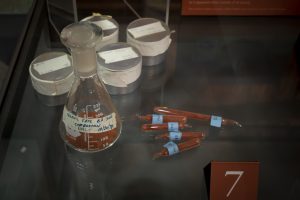
Is there life on Mars?
Engineer and inventor Gilbert V. Levin ’47, PhD ’63, says “Yes!”
Levin was the experimenter of the Labeled Release experiment, which was sent to Mars on NASA’s 1976 Viking missions to answer that question. Some other scientists disagree with him, however, and the issue has been hotly debated ever since. We sat down with Levin to discuss his career and how he views that famous experiment four decades later.
Q: Tell us a little about your background.
 A: Growing up in Baltimore, I wanted to become a journalist, but when I was a high school senior, I met a sanitary engineer and thought that profession sounded fascinating. He told me Johns Hopkins had a great program and suggested I talk to someone there. I sat down with Abel Wolman ’15, who explained that sanitary engineers work to save the world by cleaning the water and air, and addressing all manner of public health concerns. I enrolled at Hopkins in 1941, but World War II interrupted; I became a shipboard radio operator in the Merchant Marine, sailing around the world for over two years. Returning to Hopkins in 1946, I graduated in civil engineering in 1947 and got my master’s in sanitary engineering in 1948. After that, I worked as a sanitary engineer in Maryland’s health department and as a public health engineer in the health departments of California and D.C. (It wasn’t till 1963 that I obtained my PhD in environmental engineering at Hopkins in the course of my new career as an astrobiologist.)
A: Growing up in Baltimore, I wanted to become a journalist, but when I was a high school senior, I met a sanitary engineer and thought that profession sounded fascinating. He told me Johns Hopkins had a great program and suggested I talk to someone there. I sat down with Abel Wolman ’15, who explained that sanitary engineers work to save the world by cleaning the water and air, and addressing all manner of public health concerns. I enrolled at Hopkins in 1941, but World War II interrupted; I became a shipboard radio operator in the Merchant Marine, sailing around the world for over two years. Returning to Hopkins in 1946, I graduated in civil engineering in 1947 and got my master’s in sanitary engineering in 1948. After that, I worked as a sanitary engineer in Maryland’s health department and as a public health engineer in the health departments of California and D.C. (It wasn’t till 1963 that I obtained my PhD in environmental engineering at Hopkins in the course of my new career as an astrobiologist.)
Q: How did your work in California lead to the Viking Labeled Release experiment?
A: Twice a week, I’d go to Santa Monica Bay to take water samples where the public swam. I brought the samples back to a lab in LA to be tested for pollution. A sample was placed in a test tube with a broth of nutrients. If bacteria were present, they would eat the nutrients and produce little gas bubbles. The process took about two to three days. I hit on the idea of using 14C to tag the nutrients with radioactivity in order to detect their bubbles more quickly and easily. I tried the idea at the Georgetown School of Medicine when I was working for the D.C. Department of Public Health. It worked! We had results in 30 minutes. I thought this method would change the way municipal drinking water was tested in the U.S., but people were scared of radioactivity, and only Illinois adopted it.
In 1960, I found myself chatting over martinis at a party with T. Keith Glennan, NASA’s first administrator. I thought: If that damned water test of mine won’t be accepted on Earth, maybe it’ll work as an experiment to find life on Mars! I asked, “Is NASA interested in looking for life in outer space?” He said yes.
Sixteen years later, NASA sent the LR experiment to Mars aboard the Viking I and II missions, which landed on July 20 and Sept. 3, 1976. LR was basically like the water test, except several additional 14C-tagged nutrients were added to increase the possibility of attracting Mars bugs in the soil. Hopefully, any microorganisms present would produce radioactive gas from at least one of the nutrients, and thus reveal their presence.
Q: What did that LR data show?

When Viking Lander 1 reached the Chris Planitia (Golden Plain) on Mars, it analyzed the composition of the soil using X-ray florescence. Based upon the initial results, the Inorganic Analysis Team at NASA created soil analog No. 1. When more refined data became available, the same team created analog B2. The soils get their stroking red color from ferric oxide (Fe2O3), which makes up roughly 18 percent of each analog. (Object part of the Gilbert B. Levin Collection, Johns Hopkins University)
A: The first results were positive for the presence of life! This was exciting, but as a scientist, I wasn’t satisfied, and neither was NASA. When we got four positive responses, supported by five different controls, on samples taken 4,000 miles apart on the Red Planet, that was when I really got excited!
NASA’s position was, and still is, that those positive results were either false positives or caused by an unknown chemical reaction. Back in ’76, NASA cautioned me not to say we had definitively found life, so I said our experiment got results “consistent with the presence of life.” And that is how I felt—optimistic but skeptical—until 1997. If you’re an objective scientist, you have to follow the evidence, and the evidence was mounting that our results were correct. That’s when I went public, saying in a talk at a SPIE [Society of Photo-optical Instrumentation Engineers] annual meeting that we’d detected living microorganisms on Mars. The society immediately published the paper in its Proceedings.
Q: How was that paper received?
A: Very few supported me. Soon thereafter, I gave a talk at the National Academy of Sciences saying we detected life, and there was an uproar. Attendees shouted invectives at me. They were ready to throw shrimp at me from the shrimp bowl. One former advisor said, “You’ve disgraced yourself, and you’ve disgraced science.” I expected some pushback, but not that much. Still, I stuck to my position, and now there are other scientists who agree.
Q: Why are you so convinced?

A: Since those first tests, they’ve found evidence on Mars of methane, surface water, and complex organics: all considered possible indicators of microbial life. Also, on Earth, we’ve newly discovered many “extremophiles”: microorganisms that live under conditions even more hostile than those at the Viking sites on Mars.
If you run an experiment and you get a positive, what you’re supposed to do is repeat it. But since 1976, not a single NASA mission to Mars has carried an experiment aiming to detect life there. Yet, in truth, it would take a miracle for Mars to be sterile: It’s constantly bombarded with living microorganisms from Earth and, perhaps, other sources. Experiments have shown many species ejected from Earth by meteor impact could survive the journey and infect Mars.
Q: So what now?
A: I would like an expert panel of scientists to examine and review all the data, and draw a conclusion based on all the evidence. Unfortunately, I haven’t found any institution willing to investigate this ultimate scientific question. Also, I and my Viking co-experimenter, Patricia Ann Straat, PhD ’64, very much want to send our experiment back to Mars. We have designed an updated version that might tell us whether the life there is similar to ours, derived from a common source, or required a second genesis. This would be a mind-blowing revelation.




